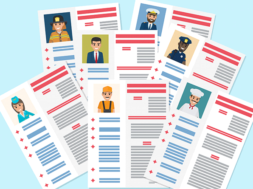
Improve Placement Rates: Competency Badges
By Larry Banks, Ph.D., Director, Competency Based Education Services, Wonderlic and Amanda Opperman, M.A., Institutional and Program Effectiveness Specialist, Wonderlic
Employers are looking for employees who can solve their problems, and they are hiring graduates who demonstrate that they have skills that matter for employability – not just a degree.
Today, employers look for evidence that an applicant knows what they need to know, and that they can do what they need to do1. Some years ago, there was a study that suggested that 96 percent of all career college students did not want to go to school for the sake of school itself2. Rather, the overriding reason they enrolled in college programs was to obtain the skills, knowledge, and learning experiences that they need to get a job or receive a promotion. As a result of their hard work, the majority of college graduates expect to be gainfully employed in a profession they prepared for. Employers, on the other hand, have become increasingly “picky.” Many are screening job candidates with various assessments to validate knowledge and skills, and identify which job applicants are best qualified for open positions.
On one hand, students and parents are demanding a return on their educational investment in the form of marketable skills. On the other, employers are seeking detailed, targeted data to pinpoint the competency of job applicants. How well are colleges meeting the demands of such employers and demonstrating that their graduates are competent and ready for work?
While GPA, academic credits, and seat time have been generally accepted measures of candidate employability, there are many thought leaders and employers that say seat time and grades are outdated, and not appropriate for employment in today’s evidence-based, performance outcomes-driven workplace.3
As such, professional certification has long been the primary means for assessing and demonstrating job-specific competency in select professions. And now, advances in certification technology have made it possible to inexpensively, securely, and reliably award badges to students who demonstrate mastery of job-specific competencies through scenario-based direct assessments that mimic real-life experience.
Institutions are beginning to use these competency badges to provide evidence that their graduates have mastered specific competencies that matter for employability and increase graduate placement rates. Administrators and career service advisors see competency badging as a way to differentiate and potentially increase starting wages for their graduates. For example, Brandman University plans to work with employers to standardize digital badges because badges that validate skills make it possible for students to display evidence of their abilities to work. Gary Brahm, chancellor of Brandman University said, “Digital badges will arm our students with a form of professional capital that has immediate value in the workplace.”4 Organizations like Wonderlic are independent providers of employer-trusted competency badges. For the past seventy-five years, Wonderlic has assessed job applicants for readiness in various professions, and has developed a database full of job-specific competencies.
Recently, Wonderlic began working with BadgeCert to provide a secure, centralized location for managing its Measures of Vocational Proficiencies (MVPs) Digital Badges. Wonderlic’s MVPs assess employer-rated, must-have competencies. Fedilis is another organization involved in the badging movement. Gunnar Counselman CEO of Fedilis said, “All a credential or badge is at its core is a letter of recommendation — an organization or person vouching for the abilities of another. A degree therefore is a type of badge.”5 Even companies like Dale Carnegie Training have implemented badging to show workplace competence.
Dale Carnegie Training competency badges are structured around essential workplace skills like collaboration, presentation, closing sales, and leading teams6.
Competency badges
To accredit means to give “credit” for doing something, and to “recognize” is to acknowledge that someone has a special skill or has done something of notice. In the knowledge economy, employers value people who demonstrate skills and knowledge, and rely on accreditation and credentials to determine who has the value and skills they are looking for. Badging is one way to accredit or recognize an individual’s demonstrated knowledge and skills, which is why some thought leaders believe competency badging may contribute to the construction of a graduate’s professional identity7. In the United States, professional certification has swelled to become the second most common postsecondary award8. According to the MacArthur Foundation, “Digital badges are an assessment and credentialing mechanism that is housed and managed online.
Badges are designed to make visible and validate learning in both formal and informal settings, and hold the potential to help transform where and how learning is valued.”9
Futurists suggest employer and employee crowdsourcing may be the way that employment competency maps will be designed10. In fact, the movement has already started. Wikipedia was one of the first crowdsourcing databases of its kind11. Wikipedia has a pretty good description of project manager responsibilities and general competencies. Through Wiki’s crowdsourcing, competency badges in the areas of developing project plans, managing risk, project budgets, conflicts and teams could be developed. The question is – how do we know we can trust issuers of those competency badges?
A competency badge is a criteria- and evidence-based trust relationship between a badge issuer and a badge recipient12. This means that the question of who issues the badge should not be taken lightly. For example, Wonderlic surveys employers, trade associations, faculty, and learning resources to identify and vet the employment competencies that should be badged. At Wonderlic, assessment questions are created by psychometricians and administered in a secure and proctored environment. Competency badges are powerful in their simplicity, and in Wonderlic’s case, the employer-vetted competencies measured by the MVPs can be trusted because Wonderlic’s measurement methodology helps ensure valid and reliable assessment. Contrary to a graduate’s resume, which is purely declarative and difficult to verify, MVP competency badges are verifiable and secured online. While recognition and student achievement can accredit broad ranges of learning outcomes from simple skills to full degrees, badges help graduates specifically demonstrate high value, employer-rated competencies.
Employability
Scrutiny of higher education by policy makers has led to questions regarding the quality of education and the reliability of data used to evaluate the quality of student outcomes. One result has been the Department of Education’s creation of the Gainful Employment Rule. In short, the Gainful Employment Rule is meant to help to ensure that students who incur debt for higher education receive the education and training needed to obtain a level of employment that provides sufficient wages to make repayment of that debt affordable. Programmatic outcomes must lead graduates to viable occupations, and institutions are responsible for monitoring quality assurance13.
It is important to note that the focus has shifted from institutional outcomes to programmatic outcomes. Now more than ever, schools need to focus on programmatic outcomes, not just institutional data collection.
Surveys that indicate happy or satisfied students are no longer enough. Competency badging is one way to monitor outcomes and instructional quality. Data from a competency badge framework can help schools demonstrate that they provide a robust education centered on employability.
Generally, there are hundreds of job applicants for a limited number of positions. How can a school help its graduates stand out from other applicants? One way to help a school’s graduates stand out is to focus on placement by skills. Placement by skills is an approach that matches and describes skills taught in the program with graduates’ experiences, competency badges, professional certifications, and other attributes to employer-stated needs, job descriptions, and competencies14. Career Service advisors that utilize placement by skills should improve graduate placement rates, potentially increase starting wages, and obtain documentation to record, maintain, and justify graduate placement in related fields. Competency badging is a way for Career Service advisors to work with graduates to secure employment, and in addition, a method to ensure organizational fit and job satisfaction.
Summary
Forward thinking career educators are directly assessing mastery in order to better prepare graduates for employment, and Career Services staff are beginning to use competency badges as a means to improve placement rates. These colleges are ensuring their survival in the midst of our sector’s current climate, because their graduates can demonstrate they are prepared to add value in the workplace.
While recognition and student achievement is already used to accredit a wide range of learning outcomes from simple skills to a full degree, it is difficult for graduates to specifically demonstrate high value, employer-rated competencies. In addition to a degree or diploma, college graduates are often encouraged to obtain professional certificates, and in some cases, professional certification is required to demonstrate competency and obtain licensure. Professional certification is not the same as a competency badging. Generally, competency badges are awarded for specific knowledge and skills. Career Service advisors should consider placing graduates by skills. Placement by skills utilizes competency badges as evidence that a job applicant has the skills listed in a job description. Competency badging is one way that schools can differentiate its pending graduates and a process for Career Services to provide evidence of employability.

Dr. Larry Banks is the Director of Competency Based Education Services at Wonderlic. Previously, he was Provost and Vice President of operations for the Daymar Colleges Group, which includes 35 career tracks and 16 campuses in Tennessee, Ohio, and Kentucky, as well as online degree programs. Banks was Associate Provost at Western Governors University; Provost at Rocky Mountain University of Health Professions; and Vice President of Academics at Eagle Gate College. Dr. Banks specializes in retention and learning strategies. He earned his doctorate degree in Business Administration from Touro University International.
Contact Information:Larry Banks, Ph.D. // Director of Competency Based Education Services // Wonderlic // lvbanks@msn.com

Amanda Opperman Institutional and Program Effectiveness Specialist at Wonderlic, is a veteran higher education professional with vast experience in and out of the classroom. She leads initiatives to help institutions with the achievement and measurement of outcomes, including assessment implementation and effectiveness planning. She began her career in the field of higher education as a Rhetoric & Writing Studies professor at San Diego State University. Most recently, she served as the Program Director at California University of Management and Sciences. She has also served as Vice Chancellor at Southern States University and Academic Director at Hancock International College. She is currently writing her dissertation about the effects of cognition on the attainment of learning outcomes as part of her doctoral studies in the San Diego State University/Claremont Graduate University joint-PhD in Education. She also holds a B.A. and an M.A. in English Literature.
Contact Information:Amanda Opperman // Institutional and Program Effectiveness Specialist // Wonderlic // 847.549.5513 // Amanda.Opperman@wonderlic.com
Citations
1http://humanresources.about.com/od/hire-employees/tp/resume-red-flags-for-employers.htm
2Pace, J. (2012). The Pacific Institute Conference
3https://www.insidehighered.com/news/2014/01/03/uc-daviss-groundbreaking-digital-badge-system-new-sustainable-agriculture-program
4http://campustechnology.com/articles/2015/01/07/brandman-u-adds-digital-badges-for-competency-ed-students.aspx
5http://pando.com/2014/07/24/7-ways-to-fix-the-most-important-problem-facing-online-education/
6http://www.dalecarnegie.com/professional-badging/competency-based-badges/
7http://www.hastac.org/files/notre_dame_presentation_-_draft_12_font.pdf
8http://www.inpathways.net/ipcnlibrary/ViewBiblio.aspx?aid=11403
9http://www.macfound.org/programs/digital-badges/
10http://www.slideshare.net/szerge/recognition-and-accreditation-of-competencies-in-2030-how-different
11http://dailycrowdsource.com/20-resources/projects/349-wikipedia-the-father-of-crowdsourced-internet-project
12http://www.learningfutures.eu/category/standards/competency/
13http://www.acics.org/accreditation/content.aspx?id=5715
14http://libweb.surrey.ac.uk/library/skills/CVs%20and%20Letters/CVs%20and%20letters.htm,
http://www3.weforum.org/docs/GAC/2014/WEF_GAC_Employment_MatchingSkillsLabourMarket_Report_2014.pdf










